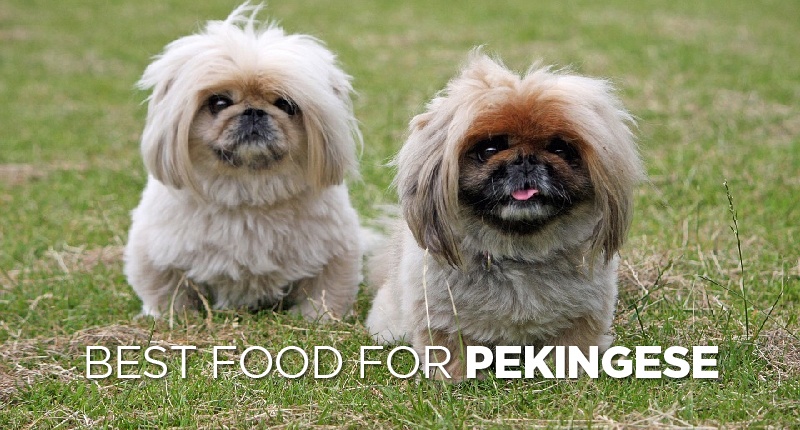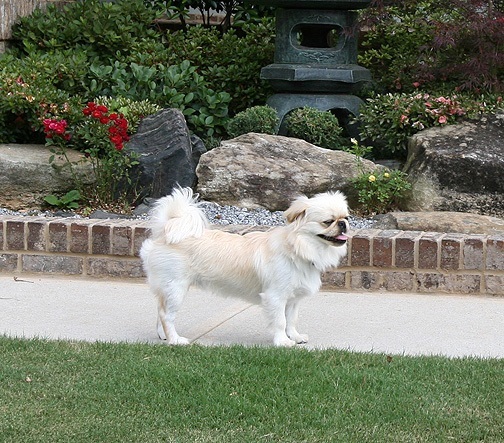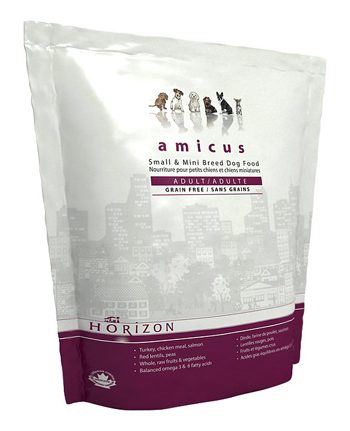Best Dog Food for Pekingese: Keep that Coat Fresh!

This canine represents one of the oldest dog breeds. But what’s the best dog food for Pekingese? What do you feed a dog breed that acted as a companion to Chinese nobles, princes, and even emperors for over 2,000 years? Well, we’ve done quite a bit of research—and have come up with an answer.
Our Top Picks: 4 Great Food Options for Pekingese
Food | Quality | Our Rating |
|---|---|---|
A | ||
A- | ||
A- | ||
B+ |
**There's more info below, but you can also click the links above to see current prices or read customer reviews on Chewy.
**Disclaimer: Our dog food reviews are based mostly on (1) our expertise and that of the experts with whom we consult and (2) the information provided by the manufacturers. We do test many dog foods (with our dog's help), but we can't test them all. As such, please remember the above recommendations are our opinions, and you should consult your vet before making changes to your dog's diet.
How Many Calories Does a Pekingese Need?
**Please note: these estimates are based on an average weight for this breed. Every dog is different. Please talk to your vet before making changes to your dog's diet.
Pekingese will grow to be 7 to 9 inches tall at the shoulder, and weigh a scant 7 to 14 pounds. They’re definitely small dogs—but this doesn’t mean that they have ‘small’ nutritional needs! They’re super-energetic, and require a diet that’s rich in nutrients, healthy fats, and meat-based protein to stay healthy, happy, and energized.
Less active Pekes will require close to 300 calories per day to stay energized, while moderately active dogs will need closer to 400. Highly active dogs of this breed, however, will need a bit more—and you might find yourself feeding as many as 600 calories per day if your dog tends to get a lot of playtime or seems to be especially energetic.
Of course, it’s always important to keep in mind that dogs need individualized attention. Try to feed each dog according to its own weight and energy level, and remember not to overfeed your Pekingese! This dog breed doesn’t fair well when overweight.
Learn More About the Pekingese!
I found an especially good video about the Pekingese in the Dogs 101 series, which is made by Animal Planet. This video does a great job of describing the breed, and provides a lot of basic information that any Peke-lover would find useful and interesting.
Pekingese Nutritional Needs
The Pekingese is a dog with unique health challenges. They tend to be prone to several different diseases and conditions—some related to their shorter snout. For this reason, it’s super-important to keep your Peke from overeating, as obesity can make such conditions more difficult to deal with.
A diet that’s rich in ingredients like blueberries, broccoli, carrots, cold-water fish, eggs, and garlic will help the Pekingese to maintain healthy eyesight. These types of ingredients will also help to build up the immune system—keeping your dog healthier, happier, and feeling as good as possible.
Since the Peke is a small dog, it can be prone to some joint problems. Some of these are genetic, but some can also be prevented with the right diet and exercise routines. To keep your Pekingese’s joints and ligaments in working order, try feeding a dog food that contains healthy amounts of chondroitin, glucosamine, and omega 3 fatty acids.
Common Health Problems


This breed tends to be pretty healthy, for the most part—though it is prone to a few different health conditions.
Making sure that your dog has come from a reputable breeder, and that its parents were tested for genetic diseases will help to weed out some of the worst possible conditions.
But even if you’ve done an awesome job of selecting a breeder, problems can still arise.
Here are a few that tend to be a bit more common with this small, yet surprisingly spirited dog breed.
Brachycephalic Syndrome
This condition, also known as BAOS, is technically known as “Brachycephalic Airway Obstruction Syndrome”.
An article posted on ACVS.org said this about BAOS…
“Certain breeds of dogs and cats are prone to difficult, obstructive breathing because of the shape of their head, muzzle and throat. The most common dogs affected are the “brachycephalic” breeds. Brachycephalic means “short-headed.””
While this condition sometimes requires surgery, you can do a lot to avoid related problems in your dog by keeping him/her from becoming obese. This can be accomplished by feeding your Peke a well-rounded diet of highly-nutritional food, and by restricting calories to the recommended maximum.
Cataracts
This eye problem manifests itself as a cloudiness, greyness, or bluishness in the lens of the dog’s eye—and it may or may not end up affecting its eyesight. Sometimes, it requires surgery to repair—though you can help to prevent a lot of eye problems like this in your Pekingese by feeding a diet that’s rich in foods like blueberries, broccoli, eggs, or cold water fish.
This article does a great job of explaining why these and other ingredients are so good for your dog’s eyesight. I definitely recommend a read-through if you’re planning on raising a Pekingese or are looking for ways to help improve your dog’s eye-health.
Slipped Stifles
This condition, also known as ‘Patellar Luxation’, is caused by a patella that doesn’t quite line up the way it should—and often manifests itself as a slipped kneecap. It can happen very quickly, and can also disappear just as fast as it happened—though in the long run, if it keeps happening, it can cause a lot of pain and trouble for your pet.
This article does a great job of explaining the condition in detail. To help prevent this and other joint/ligament problems in your pet, you should try feeding your dog a diet that’s rich in glucosamine, chondroitin, and/or omega 3 fatty acids. Foods like Avocado can also help (if you can get your dog to eat them).
How to Feed a Pekingese Puppy
Pekinese pups should start the weaning process between 3 and 4 weeks of age. Try introducing puppy food around this time to get things started—but don’t be surprised if it takes a little while for the pups to catch on. At first, you might have to wet the food with a bit of goat’s milk to make it easier for the new little puppies to chew.
Pekinese pups should start the weaning process between 3 and 4 weeks of age.
Pekingese puppies will tend to weigh somewhere around 3 to 4 pounds by the time they’re 8 weeks old—though this weight will definitely vary by pup. An 8 week old Peke puppy will probably need around 150 calories per day to stay energized—or possibly more if it’s larger or highly active.
Most breeders don’t recommend that you separate the puppy from its litter until somewhere around weeks 9 or 10 of its life, as doing so before this point could keep it from getting the socialization that it needs from its mother and litter-mates. Besides—a good breeder will start getting the puppies used to human interaction at a much younger age anyway. This will enable them to be good and ready to ‘leave the nest’ and join their adopted human family as soon as they’re old enough.
Our Recommendation for Pekingese: Amicus Grain-Free Small & Mini Breed
There are obviously a lot of awesome dog food choices out there right now—but after doing our research and examining the facts, we came to the conclusion that one of the best dog food choices for a Pekingese is Amicus Grain Free Small & Mini Breed Dog Food.
We loved this dry dog food blend because it contains everything that’s important to your Pekingese companion. It’s grain free, so it’ll be easy on the digestive system and contain minimal-to-no fillers.
It also contains Salmon, Blueberries, and Eggs—which are awesome for eye health and perfect for preventing vision problems, like cataracts.
Since Pekingese dogs are smaller, they can tend to suffer from ‘slipped stifles’—but this dog food contains healthy amounts of Glucosamine, Chondroitin, and Omega 3 Fatty Acids, which can help to prevent joint and ligament problems altogether.
- Contains high-quality joint supplements
- Ingredients that promote eye health
- Grain-free, raw components
- Contains a few controversial ingredients (e.g. alfalfa meal)
- Contains pea fiber, which is mostly a filler
Pros and Cons
The best thing about Amicus is that it’s loaded with all of the basic nutrients that a dog could need, including lean meats, quality amino acids, vitamins, minerals, and a low glycemic index ingredient composition. This will help to keep your dog from becoming obese, and will also help to decrease the odds of conditions like diabetes.
If you’re interested in a high-quality food and don’t want to mess around with cheap fillers or low-quality kibble, then I would definitely recommend that you check out Amicus Grain Free Small & Mini Breed Dog Food as a possible meal choice for your favorite Pekingese companion.
Image credits: Chewy.com, https://www.flickr.com/photos/12835891@N00/


